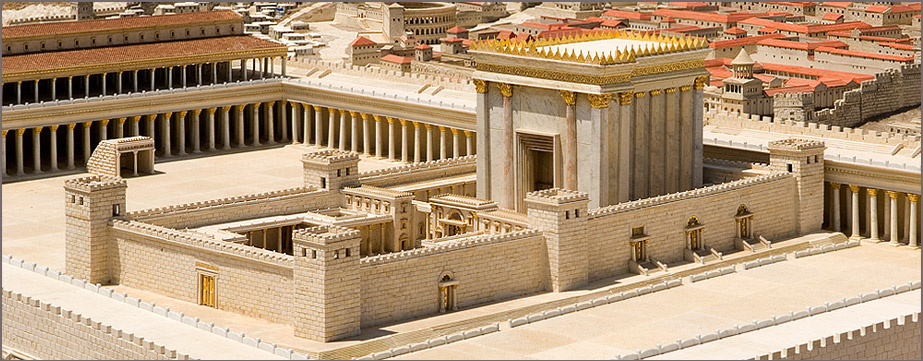Our body is a temple of the Spirit, says Paul (1 Corinthians 3:16 and 6:19). In Greek he uses the word naos for temple, which is just the temple building, in which the holy and the holy of holies are located. So the court is not inside our body, but constitutes the outside, that which we perceive! Hold this thought for a moment as you continue reading.
The court of our temple represents the outer world as we perceive it from the darkened consciousness, including the visible form of our physical body. The truth we believe in our inner world, we project onto / into our outer world, which we then perceive with our (physical) senses. As long as our consciousness (our inner world) is darkened, we perceive in our outer world a reality distorted by darkness. We project from our darkened consciousness a dark blanket over the kingdom of God, which deprives us of the sight of God’s glory (which fills the whole earth; Isaiah 6:3). From our darkened perception, it is understandable that we think the kingdom of God is yet to be established or built, which leads to all kinds of religious activities. By continuing to align our inner world with the darkened perception of the outer world, we become trapped in a vicious cycle. Paul describes this way of life as a walk according to the flesh, which is a reference to living in the court of our temple. This refers to the outside, that which we perceive with our (natural) eyes (and other senses).
The old covenant focused on this outside, called by Paul the flesh (not “soma,” but “sarx”) or also called the old man. The sacrificial system under the old covenant was about the justification of the old man. It did not lead to redemption / deliverance from the old man, leaving the power of sin active in their lives. The temple, which played an important role under the old covenant, gives us a vista of the new covenant, the covenant by which God has promised us complete redemption from the curse of sin (missing the purpose) and (physical) death.
A characteristic of the court was separation. Separation between priests and the ‘common’ people; separation between men and women; separation between castrated and uncastrated. Living out of the court causes us to make distinctions where for God there is no separation. Consider, for example, separating between Christians and non-Christians; between those who have received the Spirit and those who have not; between the born-again and the non-born-again. As long as we walk according to the flesh, we make distinctions where in reality there are none. For in Christ, who is everything and in all, there is no distinction at all (Galatians 3:28). Furthermore, in the court there were the altar of burnt offering, the brazen sea and the laver. As long as we walk according to the flesh (through identification with the old man), we will see ourselves as imperfect, thus continuing to engage in confession of guilt, ‘sacrifice’ for forgiveness of sins (seeing Jesus as a sin offering!), sanctification and cleansing of the outside. In summary, the court is characterized as a life in which we try to bring the old man into line in order to be justified in accordance with the law and thus gain access to the holy place. Paul calls this righteousness based on the law; self-righteousness. According to Paul, as long as we place our hope in the righteousness of the law, we render Christ (who is in the holy of our temple!) inactive and thus place ourselves outside of grace (Galatians 5:4). Since self-righteousness does not give us access to the holy place (grace), a walk according to the flesh keeps us imprisoned in the court of our temple. In the outer court, we will find no deliverance from the curse of sin and death and continue to live as slaves/prisoners as a result of darkened consciousness.
Inside our temple of the Spirit (the naos) are the holy and the holy of holies. These are two layers in man’s subconscious, which we can become aware of by going the way inside. We are dealing here with the magisterial design of man, designed by God as the great Architect. Every human being is a temple of the holy Spirit. In the subconscious of every human being is the holy and the holy of holies. There is no distinction! We are connected as humanity, no one excluded. Only we do not perceive it because of our darkened consciousness.
The holy represents the kingdom of Light, the place where we become aware of our Christ identity. In the holy stood the golden lampstand, whose oil of the Spirit keeps the lamps burning and our consciousness (the “eye”; Luke 11:34) is illuminated. Living from our holiness means walking 24/7 in the anointing of God’s Spirit. Furthermore, in the holy place we find the tables with the showbread, which is a picture of God’s provision for those who serve as ‘priests’ in the kingdom of heavens. And finally, in the holy place we find the altar of incense, which is a picture of the joy and gratitude that rises like a sweet smell before God.
We can enter our holy one only by removing the covering of the flesh (mind of flesh). This is done by renewal of mind (metanoia; mind-shift). Indeed, once the covering is removed, we begin to see in our holy place the glory of the Lord (Christ in us!), as in a mirror (2 Corinthians 3:18). Behind the covering we begin to see that we ourselves are the glory of the Lord, the Lord’s anointed, Christ. Once we have become aware of this (which goes beyond rational knowledge/belief), we are born of the Spirit (of God) (born again). Once born of the Spirit, we no longer know anyone according to the flesh (behold all things have become new; 2 Corinthians 5:17), which automatically eliminates the distinction with others who would still be non-born-again. We have then become aware that Christ is everything and in all (Colossians 3:11b). Once we have entered the holiness of our temple, the fruit and gifts of the Spirit will naturally become visible in and through our lives.
By holding the mind of flesh for crucified, the covering is removed and we enter our holy one, where we come to the full knowledge (consciousness) of Christ. At that point, the transformation of our physical form (Greek: metamorphosis) from glory to glory begins (2 Corinthians 3:18). This eventually leads to the ‘putting on’ of a glorified/heavenly body (the glorification), with which we will enter the holy of holies of our temple (the kingdom of God). Our physical bodies of flesh and blood cannot inherit the kingdom of God (1 Corinthians 15:50), because of the inaccessible Light in the holy of holies. To enter the holy of holies, our bodies will have to transform into a glorified body, which is the completion of theosis or deification (deification), through which we become partakers of the divine nature (2 Peter 1:4). The holy of holies in the temple of our body is the place of God-consciousness, where God is everything and in all (1 Corinthians 15:28). Paul calls this the ’third heaven’, in which he was temporarily ‘drawn up’ during his life (2 Corinthians 12:2) and into which he later entered permanently.
The purpose of our life here on earth is to enter from the court (the realm of darkness, where we walk according to the flesh) into our inner chamber (our subconscious). First into our holy (the kingdom of Light), where we walk in the Spirit and ‘put on’ imperishability and finally into our holy of holies (the kingdom of God), where we ‘put on’ immortality and thereby enter eternal life. All this without seeing the second (physical) death.
We can only make the transition from the court through the holy to the holy of holies in the temple of our body through growth in (enlightenment of) our spiritual consciousness, and that requires conversion and faith. Repenting (metanoia) from carnal thinking (mind of flesh; focused on outside/’earth’) to spiritual thinking (mind of Christ; focused on inside/’heaven’). Faith in who we really are (the Lord’s Anointed One; Christ) and faith in the reality of the kingdom of God that is already here and now in its perfect glory within us; even if we cannot yet perceive it as a result of still darkened consciousness.
This is the Way of salvation (Acts 16:17) that Jesus revealed to us and the salvation that Paul (and others) wrote about in the New Testament.
We will have to become people of the Way again.
“Glorify then God with your body.” (1 Corinthians 6:20b)
Click here for a schematic representation of the growth in consciousness, as described in this blog.
Do you have any questions about the content of this blog, want to discuss it further? Then don’t hesitate and contact us.
Sharing this blog via social media is greatly appreciated. You can easily do so using the shortcuts below.

